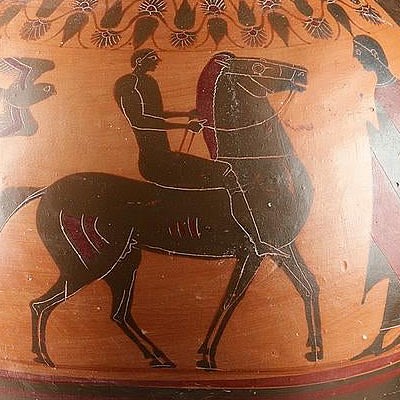Troodon Dinosaur Eggs in Matrix, Clutch of 11
Lot 129b
About Seller
Artemis Gallery
686 S Taylor Ave, Ste 106
Louisville, CO 80027
United States
Selling antiquities, ancient and ethnographic art online since 1993, Artemis Gallery specializes in Classical Antiquities (Egyptian, Greek, Roman, Near Eastern), Asian, Pre-Columbian, African / Tribal / Oceanographic art. Our extensive inventory includes pottery, stone, metal, wood, glass and textil...Read more
Categories
Estimate:
$12,000 - $18,000
Absentee vs Live bid
Two ways to bid:
- Leave a max absentee bid and the platform will bid on your behalf up to your maximum bid during the live auction.
- Bid live during the auction and your bids will be submitted real-time to the auctioneer.
Bid Increments
| Price | Bid Increment |
|---|---|
| $0 | $25 |
| $300 | $50 |
| $1,000 | $100 |
| $2,000 | $250 |
| $5,000 | $500 |
| $10,000 | $1,000 |
| $20,000 | $2,500 |
| $50,000 | $5,000 |
| $100,000 | $10,000 |
| $200,000 | $20,000 |
About Auction
By Artemis Gallery
Jun 4, 2020
Set Reminder
2020-06-04 10:00:00
2020-06-04 10:00:00
America/New_York
Bidsquare
Bidsquare : Exceptional Antiquities, Asian, Ethnographic
https://www.bidsquare.com/auctions/artemis-gallery/exceptional-antiquities-asian-ethnographic-5185
An important one-day auction featuring museum-worthy examples of Egyptian, Greek, Roman, Etruscan, Near Eastern, Far East / Asian, Pre-Columbian, African / Tribal, Oceanic, Native American, Spanish Colonial, Russian, Fossils, Ancient Jewelry, Fine Art, so much more! Artemis Gallery info@artemisgallery.com
An important one-day auction featuring museum-worthy examples of Egyptian, Greek, Roman, Etruscan, Near Eastern, Far East / Asian, Pre-Columbian, African / Tribal, Oceanic, Native American, Spanish Colonial, Russian, Fossils, Ancient Jewelry, Fine Art, so much more! Artemis Gallery info@artemisgallery.com
- Lot Description
North America or Siberia, Late Cretaceous period, ca. 77.5 to 76.5 million years ago. A clutch of eleven Troodon eggs, beautifully preserved in their reddish-brown matrix. The name Troodon refers to several species of bird-like dinosaurs found mainly in the northern Rocky Mountains, with a few specimens known from northern Alaska, Siberia, and the western Russia/China border. The eggs are elongated, with a grey-blue color and obvious shell structure underneath a thin layer of red-brown deposits. When born, Troodons may have been some of the smartest dinosaurs - their brain cases are similar to those of modern birds. They walked and ran on two long legs and had three-fingered hands that they would have used to hunt their food, primarily small lizards and mammals. Size: 5.75" L x 10.5" W x 4" H (14.6 cm x 26.7 cm x 10.2 cm)
These eggs are remarkable in the history of dinosaurs - note how they are standing up vertically in the matrix? This is evidence of a very specific nesting habit. Today, most birds nest by sitting on the eggs and warming them, with their bodies directly in contact with the egg shells. Crocodiles, their relatives, and most dinosaurs bury their nests to keep their eggs warm. Troodons therefore represent a link between dinosaurs and their evolutionary descendants, birds. This clutch and others like it provide potent evidence that dinosaurs are still among us - flying around, perching on telephone wires, and stealing french fries out of our fingers at the beach.
Provenance: ex-A Coin Exchange, Tarzana, California, USA, acquired at the Tucson Gem and Mineral Show in 2008
All items legal to buy/sell under U.S. Statute covering cultural patrimony Code 2600, CHAPTER 14, and are guaranteed to be as described or your money back.
A Certificate of Authenticity will accompany all winning bids.
We ship worldwide and handle all shipping in-house for your convenience.
#146015The eggs are preserved in the matrix and partially contained within it. The matrix has been repaired from three or four large pieces. Most of the eggs have had their shells professionally preserved with adhesive but this is almost indiscernible when looking at the whole. Great deposits on all surfaces with nice preservation of egg shell surfaces.Condition
- Shipping Info
-
All shipping is handled in-house for your convenience. Your invoice from Artemis Gallery will include shipping calculation instructions. If in doubt, please inquire BEFORE bidding for estimated shipping costs for individual items.
-
- Buyer's Premium



 EUR
EUR CAD
CAD AUD
AUD GBP
GBP MXN
MXN HKD
HKD CNY
CNY MYR
MYR SEK
SEK SGD
SGD CHF
CHF THB
THB
















